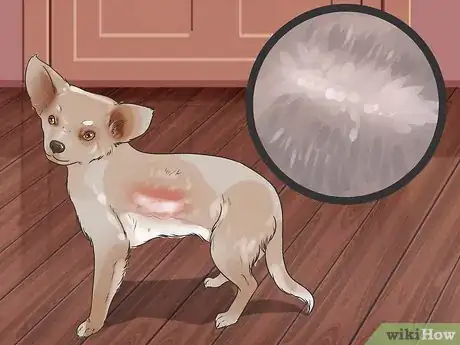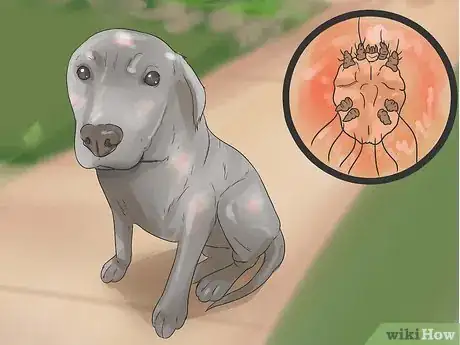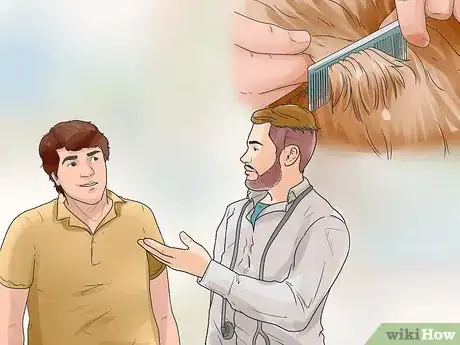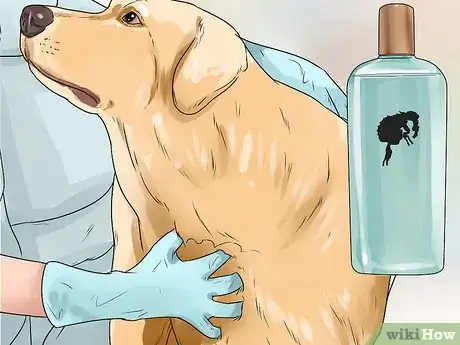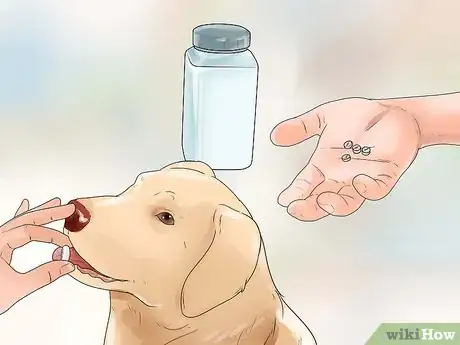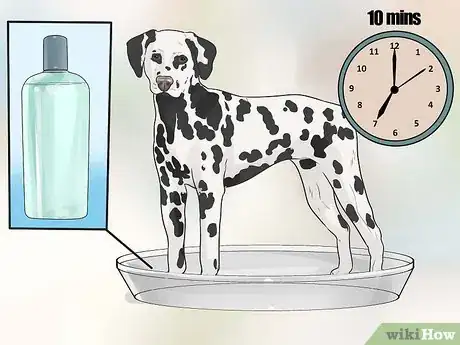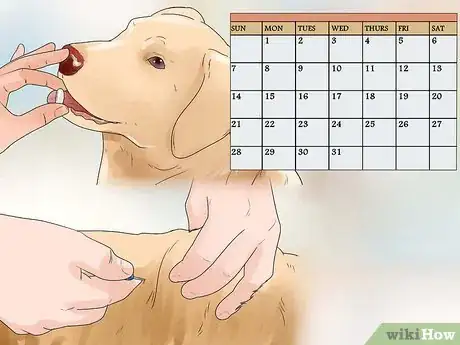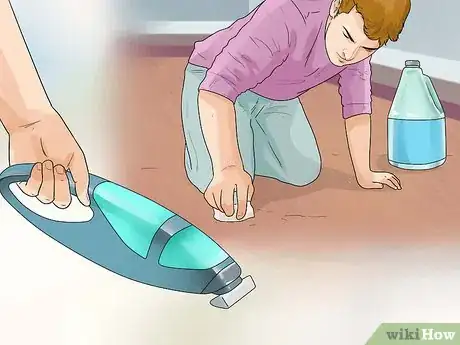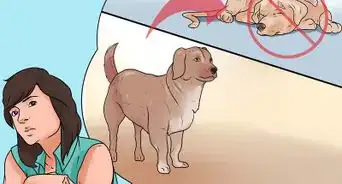This article was co-authored by Pippa Elliott, MRCVS. Dr. Elliott, BVMS, MRCVS is a veterinarian with over 30 years of experience in veterinary surgery and companion animal practice. She graduated from the University of Glasgow in 1987 with a degree in veterinary medicine and surgery. She has worked at the same animal clinic in her hometown for over 20 years.
There are 8 references cited in this article, which can be found at the bottom of the page.
wikiHow marks an article as reader-approved once it receives enough positive feedback. In this case, 92% of readers who voted found the article helpful, earning it our reader-approved status.
This article has been viewed 107,700 times.
You may have seen a dog with patches of hair or sores on its skin, or had to deal with this in your own dog. Sometimes, this condition is the result of a parasitic infection called mange. There are three different types of mange, each the result of a different type of mite. These mites are demodex, sarcoptes scabiei, and cheyletiella. The mites either live on the skin surface or burrow into the skin. The result is usually a lot of irritation and itchiness. The dog may also get secondary bacterial infections, which leads to sores and bald spots. The outbreak can be in only specific places on your dog's body, such as the face and feet. When the outbreak is all over the body, it is described as "generalized." Two forms can be prevented (sarcoptic and cheyletiella) whereas demodex cannot. However, it can be controlled if you are aware of the symptoms and obtain and apply the correct treatment. Effective treatment requires prescription medication, which means your first stop for a dog with skin problems should be your veterinarian.
Steps
Monitoring your Dog’s Irritation
-
1Monitor where your dog is itching his body. Is there a certain area on the body that is itchier than others? Does your pet lick his feet, under his tail, or along his belly?
- The most common areas of irritation for allergic dogs are around the back and tail, the abdomen, and the legs and paws.
-
2Check for cheyletiella mange. To the naked eye, this type of mite looks like flakes of dandruff. It is also a slow moving mite. You can see this mite when you brush the dog’s coat over some paper. It can also be trapped on sticky tape for diagnostic purposes. [1]
- Your dog will be moderately irritated by these mites. Puppies may experience a more severe infestation due to an immature immune system.[2]
Advertisement -
3Check for sarcoptic mange. Sarcoptic mange (Sarcoptes scabei) is a parasitic mite infestation. The dog may have red, scaly skin in some areas.[3] Sarcoptic mange can cause significant skin lesions and distress for the dog because the mite causes severe itching.[4]
- Dogs can catch sarcoptic mange very easily and it is highly infectious to the species. While these mites will bite people, they don't usually cause major problems.
-
4Check for demodectic mange. Demodectic (red mange) is caused by small mites found naturally on most dogs but do not generally cause skin problems unless the dog’s immune system is compromised. Demodex is most commonly seen in puppies, because their immune systems are still developing.[5]
- Demodectic mange is not very contagious and people cannot contract it. It is generally passed on to nursing puppies by the mother. This mange is most noticeable around the eyes and mouth when the young puppy’s immune system does not keep the mite in check.[6]
- A predisposition for this skin problem may be inherited. It is not uncommon for the puppies to have Demodex if their parents also had Demodex at some point in their lives.[7]
Visiting Your Veterinarian
-
1Take your dog to the vet when you suspect mites. Consult your veterinarian for the best treatment for the type of mange seen in your dog. Not all mange mites react to all treatments and some breeds of dogs cannot tolerate some treatments. Never use any medications or treatments without your veterinarian's approval.
- Your vet will determine what kind of mites are plaguing your dog. Effective treatment differs depending on the mite involved, so diagnosis of the mite type is critical.
-
2Ask your vet about a coat brushing. A coat brushing is a simple matter of standing the dog over a piece of white paper and roughing up the coat to make dander and debris fall onto the paper. The vet then deposits the debris onto a microscope slide for examination.
- An alternative is to use clear sticky tape to collect dander samples direct from the coat for microscope examination.
- This is the most common method of diagnosis for cheyletiella. To the naked eye, it looks like flakes of dandruff. It is also a slow moving mite, and can be trapped on sticky tape. Other methods are needed for the other two mite types. [8]
- Sarcoptes is another mite that lives on the skin surface, and it can sometimes be picked up on coat brushings or skin scrapes. However, it is fast-moving and microscopic in size, so it can easily evade these tests.
-
3Have your vet draw your dog’s blood. Since sarcoptes mites are fast-moving and often too small to see, your vet might administer a blood test. This test looks for evidence of the body mounting an immune defense to the irritant action of sarcoptes mites. This test gives a yes-or-no answer to infection. However, it is only reliable once the dog has been infected for at least 2 weeks. This is how long it takes for the immune response to occur.
-
4Ask about skin scrapes. Demodex mites live within the skin, so the veterinarian needs to use a blunt scalpel blade to scrape or abrade the surface layers of the skin. This will bring the mites to the surface and capture them in the skin debris on the edge of the scalpel blade. Good-natured dogs will have no problem undergoing this procedure.
- The scrapings are looked at under the microscope to identify the typical "cigar" shape of these mites.[9]
-
5Ask about a skin biopsy. A skin biopsy may be used if the other collection methods fail to reach a diagnosis. This method is also recommended if demodex is strongly suspected. The idea is to collect a full thickness sample of skin. The pathologist will look for the presence of demodex mites within the hair follicles.
Treating Cheyletiella and Sarcoptes Mite Conditions
-
1Treat cheyletiella mites. This condition responds to a variety of different medications. Some medications carry more risk than others. It is therefore advisable to use safer alternatives when available.
- The recommended treatment is three treatments, two weeks apart with a spray containing Fipronil. Please note that this product is not licensed for this use, but widely acknowledged to be both safe and effective. It is widely recommended by specialist veterinary dermatologists.
- Alternatives include selenium sulphide shampoo used weekly for 3 to 4 treatments. This is also a safe treatment.
- A higher risk alternative is ivermectin. This treatment is given by injection at weekly intervals for 3 treatments. This can cause coma in breeds that are sensitive to ivermectin, such as collie breeds. It is best avoided unless there is a compelling reason to use it. [10]
-
2Treat sarcoptes mites. Once identified, this condition is easily treated with regular applications of certain common external application products. Recommended products will contain selamectin (such as Revolution in the US), imidacloprid (such as Advocate in the UK).
- Initially, this treatment is applied every 2 weeks for 3 treatments, and then monthly to prevent reinfection.
- Oral products can also be effective. These will contain milbemycin (Milbemax), which is given as a weekly tablet for six treatments.
- Older treatments such as Amitraz are also effective. This is an insecticidal dip that can damage the environment when disposed of improperly. It is toxic to fish if it gets into the water. Choose safer products over this treatment.
-
3Treat all dogs who have come in contact with the affected dog. Both cheyletiella and sarcoptes mites can transfer between dogs. Any dogs who have been around the affected dog should be treated with the same medication.
- Cats and other animals do not need to be treated.
-
4Clean or discard all animal bedding, collars, and leashes. Discard or thoroughly wash all of the animals' bedding, collars, leashes and any other materials worn by them. You need to rid your house of the mites. Wash all bedding and other materials in hot water. Run them through the dryer if possible.
-
5Know that humans can get itchy from sarcoptic mange. The mite that causes Sarcoptic mange can be transmitted to humans. But the mite cannot reproduce on humans. It may cause terrible itching on specific areas of the skin. The mites will, however, die off. If you start itching from these mites, your symptoms will subside within about 3 weeks.
Administering Treatments for Demodex
-
1Wait to see if your dog is irritated by the mites. Demodex is a little bit different to the other two forms of mange because the mite is not a surface dweller but burrows beneath the skin's surface. It also takes two forms:
- A localized, self-limiting infection in puppies and dogs under 12 months of age. The skin does contain the odd demodex mite, but this doesn't cause a problem unless the dog’s immune system is compromised. Because they have developing immune systems, puppies sometimes have small bald areas which are smooth and pink. But these do not bother the dog and they do not require treatment. As the pup's immune system strengthens, the body fights the infection and brings it under control.
- A generalized infection, often occurring in dogs over 12 months of age. If the areas enlarge or the patches became sticky and itchy, showing signs of secondary infection, then treatment should be started.
-
2Shampoo your dog with benzoyl peroxide. The generalized form of demodex, which happens all over the dog’s body, is more serious. The name, "red mange," reflects the intense irritation and inflammation of the skin in response to large numbers of mites within the hair follicles. You first need to shampoo the dog with a shampoo containing benzoyl peroxide. This is not a treatment in itself but has a "follicle flushing" effect, which means that it penetrates into the hair follicles and gives them a good clean out. Thus, the dog’s body is a more hostile environment for the demodex. It also dislodges some of the mites in the process.
- This type of shampoo is available at pet stores. Talk with your veterinarian for recommendations.
-
3Apply an insecticide in a weekly bath. The treatment for demodex is a weekly bath with an insecticide called amitraz. This is a liquid drug that is diluted in water and poured over the dog. Since the paws are commonly infected, have the dog stand in a small amount of the solution for 10 minutes. At least 10 minutes contact time with the skin is necessary for it to be effective.
- Do not rinse off the product. Allow it to air dry.
- Treatment is weekly and continued until 2 or 3 negative skin scrapes are obtained. Treatment can last anywhere from 4 to 12 weeks, depending on the response
- Please note amitraz is toxic to fish, birds, and reptiles. It can also aggravate asthma. The bath must always be done in a well ventilated place, preferably outdoors and the operator must wear protective waterproof clothing such as rubber gloves and a plastic apron. People with a history of asthma should not use amitraz.
-
4Try an oral medication. Because amitraz is unpleasant and is toxic to some other animals, many vets may recommend unlicensed treatments. These include:
- Milbemycin (milbemax): This is an oral wormer. It is administered at the label dose daily for 30 days beyond 2-3 negative skin scrapes taken at least 7 days apart. The drawback with this is cost. Milbemycin is expensive and the cost of 60 day course of treatment for a large dog can be prohibitive. Also, it is not always effective, in which case the dose needs to be doubled, leading to further expense.
- Ivermectin. This oral medication is administered with a low dose initially. Your veterinarian will carefully increase the dose. Daily treatment is often necessary for 3-8 months. Ivermectin can have catastrophic side effects in some dogs because the ivermectin is able to cross the blood-brain barrier and get into the brain. It can cause breathing problems, extreme incoordination and even coma. Collie breeds are known to be especially sensitive and vulnerable to these side effects. It is arguable that ivermectin should not be used on these breeds at all. [11]
-
5Clean or discard all animal bedding, collars, and leashes. Discard or thoroughly wash all of the animals' bedding, collars, leashes and any other materials worn by them. You need to rid your house of the mites. Wash all bedding and other materials in hot water. Run them through the dryer if possible.
-
6Don’t worry about treating other pets for demodex. Demodex is not infectious in the same way as cheyletiella or sarcoptes, so other pets who have been in contact with the affected dog do not need treatment.
- Puppies can become infected from their mother during the birthing process. The mites can be present in the skin for years, waiting for an opportunity to breed.
-
7Ask your vet about underlying health conditions. A suppressed immune system makes demodex infection more likely. Every effort should be made to diagnose and treat health problems. These can include underactive thyroid glands, diabetes, or Cushing's disease.
-
8Treat infections with antibiotics. The consequence of mange is often itching, broken skin, and bacterial infections. It is important to bring secondary infections under control with antibiotics (as necessary).
- Sometimes, a short course of an oral steroid is advisable to reduce the itching while drugs treat the underlying cause. The exception to steroid use is demodex, where its immunosuppressive effect could inhibit the body's ability to fight and eliminate the mites.
Keeping Your Dog in Good Health
-
1Ensure that your dog has a healthy diet. Feed your dog a well-balanced diet that contains the necessary vitamins and minerals for a strong immune system. This will put him in a better place to deal with mite infections. For instance, experts think that demodex may be burrowed into the skin of many normal dogs who don’t have skin problems. But their skin immunity keeps the numbers in check, so these dogs don't develop clinical signs of mange. When a dog’s immunity dips because of poor diet or ill health, these mites can then breed and cause a problem. [12]
-
2Keep up to date with parasite control. Most treatments for external parasites have a broader spectrum of activity that just treating fleas or heartworm. For example, a common product, Revolution, contains selamectin. This drug is effective against fleas and sarcoptic mange mites. Other common products that contain fipronil, such as Frontline and Efipro, are effective against fleas and cheyletiella. By using a product regularly, your dog will be protected if he comes in contact with these mites.
- These products won’t completely eliminate the risk of your dog getting mange. But they do eliminate the risk for certain types, depending on the product used. [13]
-
3Keep a clean environment. It is good general practice to keep a clean and hygienic living space for your dog. Dirt and debris can harbor parasites and provide them with nutrition. In contrast, a clean environment is more difficult for parasites to survive in.
- Vacuum regularly (daily if possible), and use an insecticidal flea collar in the vacuum bag to kill parasites that get vacuumed up. Try a flea collar with pyrethrin on it.
- Spray soft furnishings and carpet with an insecticidal spray designed to kill flea eggs and larvae. These products are very strong and likely to kill parasites such as cheyletiella and sarcoptes off the host (demodex live in the skin, so this is not relevant in this case). This reduces the risk of the dog reinfecting himself by being in contact with contaminated bedding. Your veterinarian can advise you of an appropriate spray. Some recommended ones might include Indorex, RIP Fleas, and Nuvan Staykill. These sprays should not be used near birds, fish or reptiles. Be sure to ventilate the room well for a couple of hours after the initial spray.
- Parasitic activity can persist for 7 months, so it’s important to address possible infestations.[14]
-
4Tidy up your yard. If your dog goes outside, make sure to have a tidy environment for him. Remove plant refuse such as dried leaves and rotting vegetation that might harbor parasites.
Expert Q&A
-
QuestionWhat should I use to kill mites in a dog kennel?
 Pippa Elliott, MRCVSDr. Elliott, BVMS, MRCVS is a veterinarian with over 30 years of experience in veterinary surgery and companion animal practice. She graduated from the University of Glasgow in 1987 with a degree in veterinary medicine and surgery. She has worked at the same animal clinic in her hometown for over 20 years.
Pippa Elliott, MRCVSDr. Elliott, BVMS, MRCVS is a veterinarian with over 30 years of experience in veterinary surgery and companion animal practice. She graduated from the University of Glasgow in 1987 with a degree in veterinary medicine and surgery. She has worked at the same animal clinic in her hometown for over 20 years.
Veterinarian The first step is to thoroughly scrub and clean the kennel. Remove all bedding and wash down the walls with a regular disinfectant (diluted as per the instructions.) Then spray the kennel with an effective environmental spray that is suitable for killing flea eggs and larvae. Allow the kennel to ventilate well for several hours before allowing the dog to return to it. Also, wash all the dog's bedding on a boil wash.
The first step is to thoroughly scrub and clean the kennel. Remove all bedding and wash down the walls with a regular disinfectant (diluted as per the instructions.) Then spray the kennel with an effective environmental spray that is suitable for killing flea eggs and larvae. Allow the kennel to ventilate well for several hours before allowing the dog to return to it. Also, wash all the dog's bedding on a boil wash.
Warnings
- There are certain breeds of dog, such as boxers, who are more susceptible to mange than others. When thinking about getting a new puppy, ask your breeder about the incidence of any types of mange for the breed.⧼thumbs_response⧽
- It is important to treat any type of mange immediately because the mites multiply quickly. They will compromise your dog’s immune system, which weakens his ability to fight off the mites. Then your dog will become susceptible to other illnesses and/or parasites.⧼thumbs_response⧽
- Be sure to check the labels on all home medications that you plan to administer to your dog. Some shampoos and insecticide dips cannot be used on pets under a certain age because they will cause illness and possibly even death. When in doubt, check with your veterinarian.⧼thumbs_response⧽
References
- ↑ How to detect common skin mites through skin scrapings. Smith. Vet Med 83, 165-170
- ↑ http://www.petmd.com/dog/conditions/skin/c_multi_cheyletiellosis
- ↑ http://www.veterinarypartner.com/Content.plx?P=A&S=0&C=0&A=616
- ↑ http://www.veterinarypartner.com/Content.plx?P=A&S=0&C=0&A=616
- ↑ http://www.veterinarypartner.com/Content.plx?P=A&S=0&C=0&A=630
- ↑ http://www.veterinarypartner.com/Content.plx?P=A&S=0&C=0&A=630
- ↑ http://www.veterinarypartner.com/Content.plx?P=A&S=0&C=0&A=630
- ↑ How to detect common skin mites through skin scrapings. Smith. Vet Med 83, 165-170
- ↑ How to detect common skin mites through skin scrapings. Smith. Vet Med 83, 165-170
- ↑ Ivermectin toxicity in 17 collies. Hopper. JVIM 16 (1), 89-94
- ↑ Ivermectin toxicity in 17 collies. Hopper. JVIM 16 (1), 89-94
- ↑ Generalized demodicosis in dogs: Clinical perspective. Shipstone. Aust Vet J, 78, 240-242
- ↑ Zoetis product data sheet for Revolution (selamectin)
- ↑ Virbac product safety sheet for Indorex
About This Article
To prevent mange in dogs, make sure that your dog is eating a well-balanced diet so that its immune system is able to deal with infections on its skin. Additionally, try to keep your pet up-to-date with parasite control medications, such as Revolution or Frontline, which can protect against certain mite infections that cause mange. You can also get rid of any mites that your dog brings inside by vacuuming its area with a flea collar inside the vacuum bag, which will kill any parasites that get sucked up. For more advice from our Veterinary co-author, including how to identify the different types of mange, read on!

